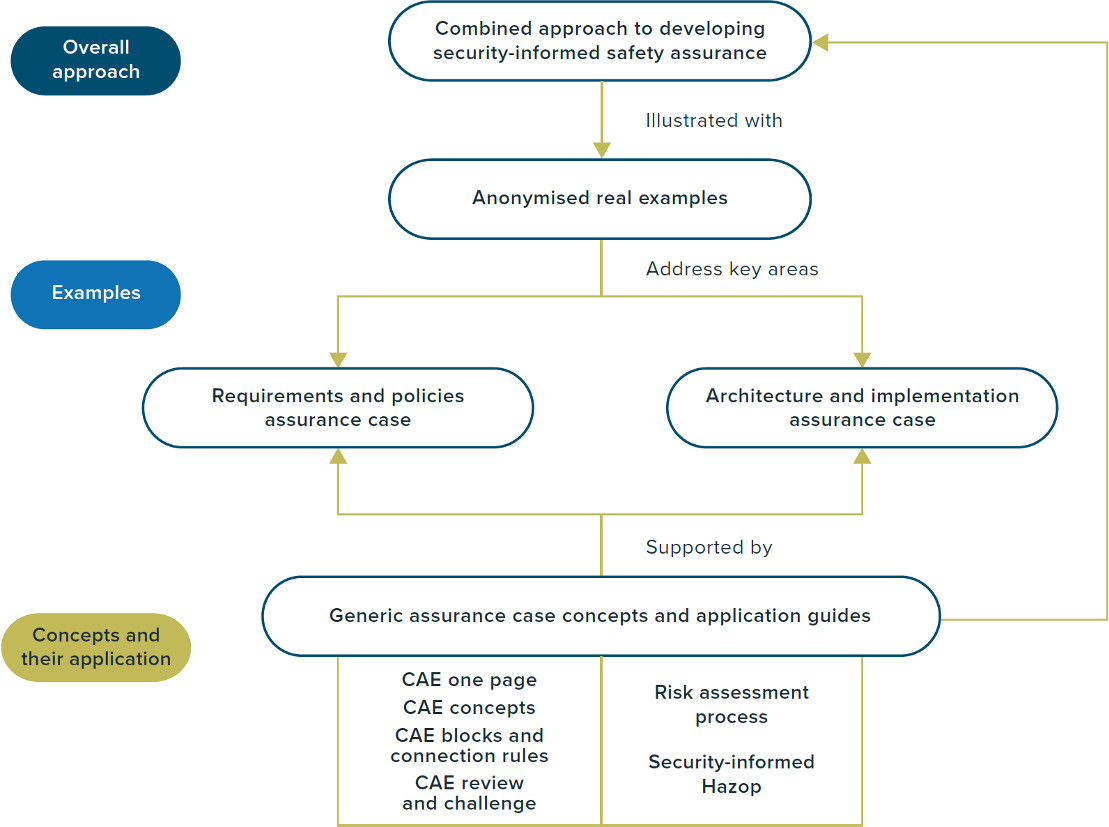Introduction
Society depends on highly connected and complex sociotechnical systems.The threats to systems have been increasing and the increased connectivity of systems exposes them to more frequent and different attacks. It also introduces more complex consequences of failure and interdependencies.
Security and safety are therefore closely interconnected and interdependent. A safety justification, or safety case, is incomplete and unconvincing without a consideration of the impact of security.
In other words “If it's not secure, it's not safe".
Guidance
The suite of guidance documents below covers extensive information on the approach to security-informed safety assurance and the Claims, Arguments and Evidence (CAE) methodology.
The Introduction to guidance document provides an introduction to the significance of security-informed safety and overview of the suite of guidance resources.
These guidance can be divided into three layers:
- detailed generic guidance on security-informed safety – the overall approach
- practical illustrative example-based guidance
- a set of generic guides on assurance case concepts and their application that provide the basis for the other guides

Security Informed Safety video
Society increasingly utilises highly connected and complex socio-technical systems.
To deliver benefits to society, these need to be effective, safe and secure.
Safety can be defined as the state of relative freedom from threat or harm caused by random, unintentional acts or events, while security is freedom from threat or harm caused by deliberate, unwanted, hostile or malicious acts.
Threats to our socio-technical systems have been increasing.
We can’t assume a safety system is immune from attack because it is built using bespoke hardware and software or separated from the outside world by an air gap.
Security and safety are interconnected and interdependent.
A safety justification or safety case is incomplete without consideration of the impact of security.
Always remember: ’If it’s not secure, it’s not safe.’
- That’s why CPNI has developed a number of industry codes of practice, standards and guidance notes to help government, regulators and industry:
- Identify safety and security issues and interdependence…
- show how to explore issues using a risk assessment process and layered assurance case view…
- provide concepts and techniques to communicate understanding of system risks and mitigation and…
- supply concrete examples to illustrate guidance
The suite of guidance documents extensively covers security-informed safety assurance and the claims, arguments and evidence – or CAE – methodology.
Depending on your background and expertise, these guidance documents can be used for different purposes…
The ‘Combined Approach to Developing Security-Informed Safety Assurance’ document should be used as an entry point for the overall approach.
The scenario-based examples provide practical guidance on the application of the combined approach using real but anonymised systems.
The concepts and application guides provide in-depth, technical guidance on the implementation of a security-informed safety approach.
To view these guidance documents, go to the links at the bottom of this webpage.
Guidance
- Rail Code of Practice for Security Informed Safety15-11-2022Download
- Security Informed Safety introduction to guidance15-11-2022Download
- Combined approach to developing security informed safety assurance15-11-2022Download
- Worked example architecture and implementation assurance case15-11-2022Download
- Worked example requirements and policies assurance case15-11-2022Download
- CAE Risk Assessment Process15-11-2022Download
- CAE one page mini guide15-11-2022Download
- CAE Concepts15-11-2022Download
- CAE Blocks and Connection Rules15-11-2022Download
- CAE Review and Challenge15-11-2022Download
- CAE Security Informed Hazard & Operability study (Hazop)15-11-2022Download